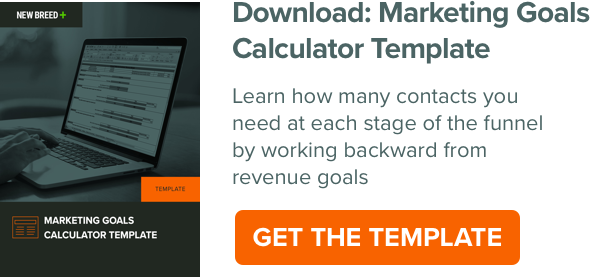5 Tips for Establishing Better Inbound Marketing KPIs

Every time Key Performance Indicator creation comes up in conversation, you can almost hear the collective corporate sigh. KPIs are completely necessary, and we happen to love the heck out of them, but crafting the right ones probably isn't an easy part of your job.
For a marketing VP, in particular, homing in on the most valuable metrics can be a challenge. As our friends at InsightSquared put it, "To CEOs and board members, a lead is a dirty four-letter word, one that ultimately doesn’t move the revenue needle very much." So, which KPIs does your CEO value? Probably only the most relevant and, well, indicative, which you can establish through a clear process.
We're not going to tell you which metrics are exactly right for you in this post. (Though to give you a reference point, some of the most popular include cost per acquisition, unique site visitors, customer churn, time on page or time on site, conversion rate and lifetime value.)
Instead, we're going to share a process and tips for establishing better KPIs that will actually help you discover which initiatives drive success and, conversely, which areas are ripe for improvement.
Crafting Better Marketing KPIs
Though your KPIs may be different for an Inbound campaign than for other projects, these tips and process ideas for establishing great ones can be used across the board, regardless of department or initiative.
And a process is necessary because, as Stacey Barr outlines, lack of process can lead to:
- measures not being used because no one sees them as relevant (useless KPIs!)
- no clear links between measures and your strategy
- no idea how to measure your goals, especially those intangible, qualitative goals
Are you ready to learn how to create useful key performance indicators? Here we go.
1. Get a baseline
Start by reviewing what's worked in the past and what has been achieved through the use of KPIs. You want to ensure your KPIs are designed for successful goal benchmarking and completion, so eliminating or adapting any that have failed your project team or department in the past is a perfect first step.
2. Identify major goals
Take a good hard look at your larger goals, and then ask a series of questions that allow you to draw out the right metrics for those goals.
For example, let's say your major goal was to significantly increase site traffic. In fact, you want to grow it about 30% by a certain date. Now start asking yourself these questions: How will I know site traffic has increased by 30%? What info can I get as a result of increased site traffic that will allow me to make changes in the future? What do I need to look at to understand my site traffic more in-depth? Asking these types of qualitative questions can lead you to your KPIs, measures like overall site traffic, traffic source distribution, click-through rates, social shares, etc.
By examining your major goals first, you can craft your KPIs to be more relevant and applicable. No one wants to create KPIs that don't really hold much significance, so work backward to move forward.
If you find yourself with a slew of KPIs your team has already proven are ineffective or useless (see your baseline from step 1!), then it's time to rethink.
3. Include leading indicators
Most marketers have a tendency to only include lagging indicators, i.e KPIs that only show how you performed. Lagging indicators are outputs, such as number of new customer acquisitions. Leading indicators instead measure inputs, things like conversion rates and opportunity age. These things can reveal what might happen in the future.
It's a lot easier, of course, to measure things that already happened. But as this HubSpot piece details, it's worth trying to include both types of indicators in your KPIs. That's because leading indicators act as business drivers "because they come before trends emerge, which can help you identify whether or not you are on track to reaching your goals. If you can identify which leading indicators will impact your future performance you will have a much better shot at success."
4. Map relevance to industry
Not every KPI makes sense for every industry. While you create yours, you'll need to think carefully about what's most relevant for your specific industry and for your business model. If you're a B2B SaaS company, you would choose KPIs very different from the ones a marketing VP at a retail company might choose, for example. Our advice? Go with the industry standard KPIs you already know make sense (from steps 1 and 2!), and then add a couple that are more relevant to your specified model and goals.
5. Create the right dashboards
Because KPIs are just no good at all unless you have the capability to measure and assess, having easy access to dashboards you created to view your KPIs is a must. We're fans of HubSpot and InsightSquared.
Creating dashboards won't necessarily help with establishing the right KPIs in your first go around, but it absolutely will help with measurement, and therefore, with getting a baseline (step 1) the next time you need to go through the process.
Using these tools, plus the steps and tips we've outlined, you'll be well on your way to overcoming this periodic challenge and establishing much better KPIs for your Inbound efforts. If you want to understand your goals in the meantime, take a stab at using our marketing goals calculator!
Olivia Perek-Clark
Olivia Perek-Clark is New Breed's Principal Solutions Architect, leading the charge on designing customized solutions within the HubSpot ecosystem. With over 10 years of experience using the HubSpot platform to drive measurable revenue success, Olivia has a passion for sharing her knowledge and insights on how to...




